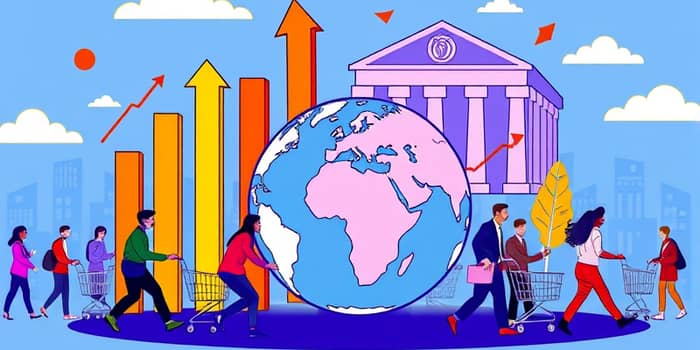
In November 2025, the global economy continues to wrestle with rising prices that touch every household and business. This article cuts through the overwhelming numbers, explains the underlying forces, and provides actionable strategies so you can navigate an inflationary era with confidence.
Across advanced and emerging markets, headline inflation remains elevated, even as some regions begin to see relief. According to the IMF, the projected headline global inflation at 4.4% for 2025 still masks deep variations. The OECD reports 4.2% year-on-year as of September, while individual economies range from near-zero rates in Japan to crisis levels in Turkey.
These figures reveal that while some economies edge back toward central bank targets, others face persistent shocks. At home, consumers see daily price adjustments in groceries, housing, and services. Around the world, policymakers weigh the urgency of support against the risk of fueling further price rises.
Headline rates only tell part of the story. Core inflation—excluding volatile items such as food and energy—remains a stubborn challenge. Several structural forces underlie this stickiness:
Beyond these factors, the economy is still adjusting to post-pandemic supply chain challenges and de-globalization and localization trends. New U.S. tariffs may push consumer goods upward, offsetting lower energy costs. Meanwhile, companies continue to automate and diversify suppliers, absorbing higher fixed expenses in pursuit of resilience.
Central banks face a delicate balancing act. The Federal Reserve has initiated modest rate cuts in September and November 2025 amid a cooling labor market. At the same time, they confront sticky core inflation despite policy efforts. In the Eurozone, the ECB maintains a wait-and-see stance as inflation nears target levels, while the Bank of England holds rates steady until evidence of sustained disinflation emerges.
In Japan, policymakers gradually exit negative rates, seeking to foster modest price gains without derailing fragile growth. Emerging market central banks in Brazil, Colombia, and Mexico are poised to ease policy further, though U.S. tariff changes could complicate their outlook.
Across all regions, a common theme emerges: the balancing act between growth and inflation has become more complex. Unexpected geopolitical shifts, energy price swings, and labor dynamics all reshape the policy calculus.
As we move into 2026, several scenarios could unfold:
In this uncertain environment, businesses and individuals can adopt targeted strategies to protect their finances and capitalize on emerging trends:
Governments, too, must balance support for vulnerable households with incentives for increased housing supply, skills training to ease labor shortages, and targeted trade agreements that limit arbitrary cost shocks.
Inflation remains one of the most pressing economic challenges of our time, affecting everything from grocery bills to mortgage rates. By understanding the latest data and structural drivers, you can make informed decisions, adapt strategies, and seize opportunities even in turbulent markets.
Whether you’re a corporate leader redesigning supply chains, an investor seeking inflation-resistant assets, or a household managing monthly budgets, the key lies in making informed financial decisions every day. Embrace a mindset of resilience, keep a close eye on core indicators, and don’t shy away from recalibrating plans as conditions evolve.
With robust analysis and practical tools, you can transform the complexities of global inflation into a roadmap for stability and growth. Now is the time to act decisively, harness insights, and shape a more secure financial future in the face of persistent price pressures.
References





